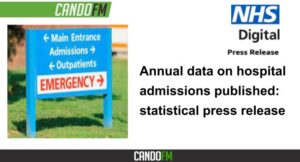
The latest annual report on hospital admissions in English NHS hospitals has been published by NHS Digital today.
The Hospital Admitted Patient Care Activity 2021-22 report includes data on Finished Consultant Episodes (FCEs)1 and Finished Admission Episodes (FAEs)2.
The data is broken down to cover information on:
- Causes of admissions
- Diagnoses on admission
- Procedures carried out
- Patient demographics
- Regional or organisational breakdowns
- Changes over time
The report covers admissions to NHS hospitals as well as NHS commissioned work in independent providers in England.
The main tables do not represent a count of individual people or patients as the same person could be admitted to hospital multiple times or seen by of number of different consultants. It is possible to analyse the HES data to provide an estimated count of people seen.
The report uses data from the Hospital Episode Statistics (HES)3, which is an invaluable tool for the NHS to understand demands on the frontline – where it is used to plan for new services and support research into new treatments and drugs.
Each record in HES includes key information including details of the patient (age, gender, geographic details), when they were treated and what they were treated for. All published figures are aggregated and anonymous.
Read the full report: Hospital Admitted Patient Care Activity 2021-22
Also published today is the Quality and Outcomes Framework (QOF) – Prevalence, Achievements and Personalised Care Adjustments Report, England 2021-22, which provides the recorded prevalence of 21 conditions4 including asthma, hypertension, dementia, diabetes and depression.
The annual publication also identifies how the recorded prevalence of these conditions has changed since the previous year.
The prevalence data is collected from GPs in England and can be broken down to regional and general practice level.
This dataset is made up of information voluntarily provided by 97.5% of general practices in England. It is collected through the QOF, which is primarily used to improve care for patients by rewarding practices for the quality of care they provide5.
Conditions are grouped into categories. These are:
- Cardiovascular6
- Respiratory7
- Lifestyle8
- High dependency and other long term conditions9
- Mental health and neurology10
- Musculoskeletal11
- Fertility, obstetrics and gynaecology12
- Quality improvement13
- Vaccination and immunisation14
Prevalence of some conditions is measured as a proportion of the total number of people registered at a surgery, whereas others are age-specific.
QOF also provides information on the activity of GPs in relation to 27 indicator groups overall – this is expressed as achievement.
Achievement scores are used to calculate what payment a general practice should receive according to the services it delivered.
Due to the COVID-19 pandemic, income protection was applied to the majority of QOF indicators in 2020-21 and 2021-22, therefore should be viewed with caution when comparing against previous years.
Read the full report: Quality and Outcomes Framework (QOF) – Prevalence, Achievements and Personalised Care Adjustments Report, England, 2021-2022







